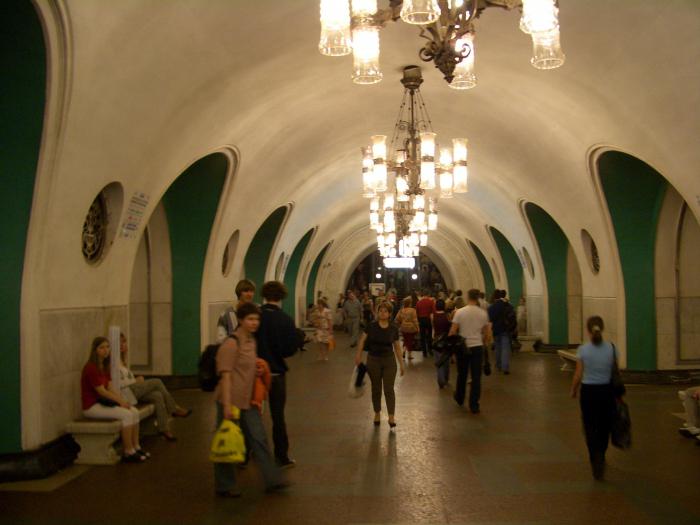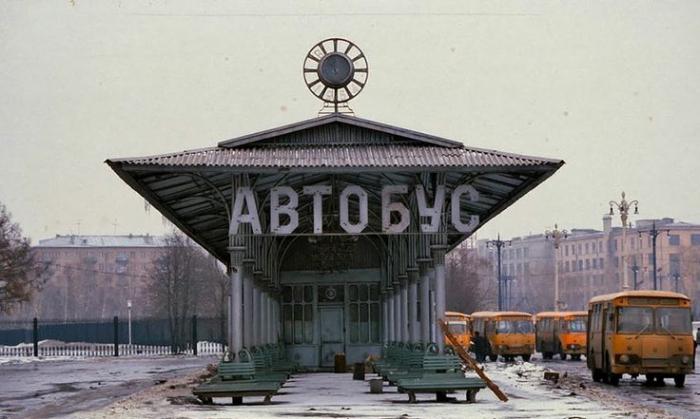The Moscow Metro, being the main public transport hub of the capital, carries a few more functions. In addition to a powerful means of protecting the population and carrying out operations for the general civil defense of the city, the Moscow metro is also a very valuable cultural monument of our country, clearly demonstrating the history of development and the stages of the formation of society.
The main exhibition of the USSR
The Exhibition of Achievements of the National Economy of the USSR (VDNKh USSR) received this name in 1959. Initially, its name sounded like "All-Union Agricultural Exhibition." The complex was opened in Moscow in 1939 on a vast territory between the Main Botanical Garden and the Ostankino Recreation Park and worked until 1941. After the war, the exposition opened only in 1954, and in 1992 it was renamed the All-Russian Exhibition Center (VVC). In the pre-war years, a similar exhibition was held on the Sparrow Hills and since 1923 was called the “All-Russian Agricultural and Handicraft Industrial Exhibition”.

The year before the renaming at VDNH, the metro opened its doors to visitors to the complex, making it much closer to the people in the literal sense of the word. The territory of VDNH also includes the monument “Worker and Collective Farm Girl”, sculptor Vera Mukhina, fountains “Friendship of the Peoples of the USSR” and “Stone Flower”, 14 fountains of the central alley, three elegant arches of the Central, Main and Southern entrances, as well as about ninety pavilions built on the area of the exhibition complex.
How to name?
VDNH metro station was launched on May 1, 1958 as the terminal station of the Riga radius “Prospect Mira” - “VSHV”. Before the exhibition was given a new name during the year, the station was named similarly to the exhibition complex located above it - “VSHV”. In 1992, after renaming VDNH in the All-Russian Exhibition Center, it was also proposed to change the name of the station, but they refused to implement this project. Other projects on assigning new names for the station, such as Vystavochnaya, Rostokino, and Cosmic, did not receive publication either — these names remained on paper forever.
Orange branch
The radius of Riga, launched in 1958, consisted of only four stations: Botanical Garden (the current Prospect Mira), Riga, Mir (aka Shcherbakovskaya and Alekseevskaya) and VSHV (now "VDNH"). How to get by metro to the city center or to an exhibition of the union scale, from now on it has ceased to be a problem. Previously, this could only be done by land transport in the capital.
Four years later, in 1962, the Kaluga radius of the branch was launched. He connected the central part of Moscow with new buildings in the southwest and reached the Novye Cheryomushki station. It is noteworthy that the Shabolovskaya station was put into operation only in 1980, although it was taken into account in the project initially. The station "Kaluga" at first was located in the depot (Traction part number five "Kaluga"). In 1974, it was closed, putting into operation a new platform of the same name.
Line development
They combined two directions in 1972, by the name of each of the former radii, they assigned the name “Kaluga-Riga Line” to the newly formed full-fledged branch. In 1978, the line was extended to the Medvedkovo station, the fourth station north of VDNKh. The metro in Moscow develops annually, enveloping in a web of its underground hauls more and more new areas of the capital. In the eighties, the line was pulled to the southwest and in 1990 opened the terminal station “Bitsevsky Park” (now “Novoyasenevskaya”) with reverse dead ends. In 2014 it was made a transfer, giving passengers the opportunity to transfer to the light metro line L1.
Pride of the nation
Despite its Soviet origin, the name of the station is still synonymous with the proud word Moscow. VDNH, the metro station next to it, the huge exhibition site of the Soviet Union, the Cosmos Hotel, as well as the notorious monument Worker and Collective Farm Girl, will forever remain a symbol of developed socialism within the capital of our state. Today, this station is no longer just a stopping point of one of the Moscow metro lines. It is also a historical monument demonstrating the architectural and engineering power of the time.
Station decoration
"VNDH" - a deep station. An underground level of minus fifty-three and a half meters makes it one of the deepest stations in the Moscow metro. The three-vaulted design of the station has nine pylons in length (eighteen in total). The platform cannot boast of a special decoration, since it was erected during the years of serious savings. Initially, it was planned to design the tops of the pylons with a green ornament framed by gilding on the theme of Florentine mosaic motifs . For this work, the artist Vladimir Andreevich Favorsky was even specially invited .

After some time, he created a special drawing for the VDNH station. The metro of the fifties was distinguished by the dissimilarity of the design of each station. And the stops themselves at that time were few. The war just recently ended, the main forces of the working people were thrown to restore the country's economy. However, the interior of the metropolitan subway was approached in detail. Not spared and "ENEA". The interweaving of oak leaves and ribbons organically adorned the first pylon of the station being built. However, shortages and savings have taken their toll. The mosaic was plastered and painted over with green paint not only the first of the supporting structures, but also each of the supports.
To the region and not only
Currently, this underground station is one of the busiest interchange nodes in the Moscow region. A significant role in this is played by the fact that it is located next to the territory of the vast exhibition complex VDNH metro.
The map of the Moscow system of high-speed transport of the city does not reflect and does not convey the fullness and scale of the daily passenger flows passing through the station. The presence of a suburban transport hub adds a significant part of people who use VDNH to get into the metro in the morning and leave it after the end of the working day, getting to the house. Mytishchi, Korolev, Sergiev Posad, Pushkino, Ivanteyevka, Forest glades - this is not a complete list of cities near Moscow, to and from which you can get by TPU bus service to VDNH. In this case, the Moscow metro serves as a logical continuation of the transport artery both to the center of the capital and to the opposite side from it.

Do not forget about the residents of nearby areas, where the Moscow metro has not yet managed to throw its branching network. Ostankino, Rostokino, Maryina Roshcha, Yaroslavl district - most of the people living here use the VDNH station to get to work or to the center of the capital. Free buses to major shopping centers, such as the Golden Babylon in Rostokino or XL in Mytishchi near Moscow, also contribute to the increase in station load. Potential visitors to shopping and entertainment galleries from all Moscow districts are attracted by the possibility of free ground transportation to the place of shopping.
Station exit
Until mid-1997, the only Northern ground lobby in the form of a rotunda, opened back in 1958, functioned. However, its capacity was clearly not enough to cope with the daily increasing load of the VDNKh metro station. Exits on both sides of Prospect Mira were opened on August 25, 1997. The southern lobby takes passengers to the underpass under the motorway and offers to rise to the surface from the side of the Cosmonauts Alley, or from the Temple of Tikhvin Icon of the Mother of God in Alekseevsky.
In June 2013, the North Lobby was closed for almost a year to repair escalators that had served their and already pretty worn out. New lifting gears entered service on June 1, 2014. Modern devices not only have increased bandwidth, but also meet all the safety standards of ISO9001-2011.
Finally
The metro station "VDNH" was and remains a symbol of development and a historical monument in the hearts of Russians. Through its underground arches, daily tourist excursions on the Moscow metro for foreign travelers pass. More than 150,000 people daily enter the cold granite of her possessions. The station was immortalized in many literary works, for example, in the novel by Dmitry Glukhovsky “Metro 2033” as “the last bastion of culture and the northern outpost of the civilization of the Kaluga-Riga line”.